Deformation Mechanisms of Magnesium Alloys with Rare-Earth and Zinc Additions under Plane Strain Compression
Abstract
:1. Introduction
2. Materials and Methods
3. Results
3.1. Grain Information of the Initial Condition
3.2. Mechanical Properties of Channel Die Compression Samples
3.3. Deformation Behaviors of the Room Temperature Samples
3.4. Deformation Behaviors of the Elevated Temperature Samples
4. Discussion
4.1. Effects of Dislocation Slip on the Deformation Process
4.2. Effects of Twinning on the Deformation Process
5. Conclusions
- (1)
- Compared to the Mg–Nd binary alloy, the addition of Zn can significantly improve the ductility of the sample at room and elevated temperatures. The yield strength of the ZN12 is slightly lower than that of the N2, while their ultimate strengths are comparable.
- (2)
- A high activity of prismatic slip is observed in early deformation stage of the ZN12 sample. The multiple activation of different deformation modes, characterized by the sigmoidal yielding phenomenon, are beneficial to the strain accommodation.
- (3)
- The ZN12 sample shows a more advanced twinning activity than its counterpart, due to its favorable orientation and its dissociation of prismatic slip. However, the rapid growth of the same twin variant consumes the parent grain, leading to the orientation change from TD to basal components.
Author Contributions
Funding
Institutional Review Board Statement
Informed Consent Statement
Data Availability Statement
Conflicts of Interest
References
- Obara, T.; Yoshinga, H.; Morozumi, S. {112̄2} <1123> Slip system in magnesium. Acta Metall. 1973, 21, 845–853. [Google Scholar]
- Al-Samman, T.; Gottstein, G. Room temperature formability of a magnesium AZ31 alloy: Examining the role of texture on the deformation mechanisms. Mater. Sci. Eng. A 2008, 488, 406–414. [Google Scholar] [CrossRef]
- Robson, J.D.; Henry, D.T.; Davis, B. Particle effects on recrystallization in magnesium–manganese alloys: Particle-stimulated nucleation. Acta Mater. 2009, 57, 2739–2747. [Google Scholar] [CrossRef]
- Mackenzie, L.W.F.; Davis, B.; Humphreys, F.J.; Lorimer, G.W. The deformation, recrystallisation and texture of three magnesium alloy extrusions. Mater. Sci. Technol. 2007, 23, 1173–1180. [Google Scholar] [CrossRef]
- Basu, I.; Al-Samman, T. Twin recrystallization mechanisms in magnesium-rare earth alloys. Acta Mater. 2015, 96, 111–132. [Google Scholar] [CrossRef]
- Stanford, N.; Barnett, M.R. The origin of “rare earth” texture development in extruded Mg-based alloys and its effect on tensile ductility. Mater. Sci. Eng. A 2008, 496, 399–408. [Google Scholar] [CrossRef]
- Basu, I.; Al-Samman, T.; Gottstein, G. Shear band-related recrystallization and grain growth in two rolled magnesium-rare earth alloys. Mater. Sci. Eng. A 2013, 579, 50–56. [Google Scholar] [CrossRef]
- Zeng, Z.R.; Zhu, Y.M.; Xu, S.W.; Bian, M.Z.; Davies, C.H.J.; Birbilis, N.; Nie, J.F. Texture evolution during static recrystallization of cold-rolled magnesium alloys. Acta Mater. 2016, 105, 479–494. [Google Scholar] [CrossRef]
- Sandlöbes, S.; Zaefferer, S.; Schestakow, I.; Yi, S.; Gonzalez-Martinez, R. On the role of non-basal deformation mechanisms for the ductility of Mg and Mg–Y alloys. Acta Mater. 2011, 59, 429–439. [Google Scholar] [CrossRef]
- Yin, B.; Wu, Z.; Curtin, W.A. First-principles calculations of stacking fault energies in Mg-Y, Mg-Al and Mg-Zn alloys and implications for <c+a> activity. Acta Mater. 2017, 136, 249–261. [Google Scholar]
- Li, X.; Al-Samman, T.; Mu, S.; Gottstein, G. Texture and microstructure development during hot deformation of ME20 magnesium alloy: Experiments and simulations. Mater. Sci. Eng. A 2011, 528, 7915–7925. [Google Scholar] [CrossRef]
- Stanford, N.; Cottam, R.; Davis, B.; Robson, J. Evaluating the effect of yttrium as a solute strengthener in magnesium using in situ neutron diffraction. Acta Mater. 2014, 78, 1–13. [Google Scholar] [CrossRef]
- Yu, M.; Cui, Y.; Wang, J.; Chen, Y.; Ding, Z.; Ying, T.; Llorca, J.; Zeng, X. Critical resolved shear stresses for slip and twinning in Mg-Y-Ca alloys and their effect on the ductility. Int. J. Plast. 2023, 162, 103525. [Google Scholar] [CrossRef]
- Yang, J.; Wang, W.; Zhang, M.; Liu, J.; Qin, S. Improving Mechanical Properties of Mg-Al-RE Alloys with the Formed Dimples of Al10Mn2RE Particles and Activated Pyramidal <a> Slip with Mn Additions. Materials 2023, 16, 6747. [Google Scholar] [PubMed]
- Mesbah, M.; Fattahi, A.; Bushroa, A.R.; Faraji, G.; Wong, K.Y.; Basirun, W.J.; Fallahpour, A.; Nasiri-Tabrizi, B. Experimental and Modelling Study of Ultra-Fine Grained ZK60 Magnesium Alloy with Simultaneously Improved Strength and Ductility Processed by Parallel Tubular Channel Angular Pressing. Met. Mater. Int. 2021, 27, 277–297. [Google Scholar] [CrossRef]
- Stanford, N.; Sha, G.; Xia, J.H.; Ringer, S.P.; Barnett, M.R. Solute segregation and texture modification in an extruded magnesium alloy containing gadolinium. Scr. Mater. 2011, 65, 919–921. [Google Scholar] [CrossRef]
- Jiang, M.G.; Xu, C.; Yan, H.; Nakata, T.; Chen, Z.W.; Lao, C.S.; Chen, R.S.; Kamado, S.; Han, E.H. Quasi-in-situ observing the rare earth texture evolution in an extruded Mg-Zn-Gd alloy with bimodal microstructure. JMA 2021, 9, 1797–1805. [Google Scholar] [CrossRef]
- Hadorn, J.P.; Hantzsche, K.; Yi, S.; Bohlen, J.; Letzig, D.; Agnew, S.R. Effects of Solute and Second-Phase Particles on the Texture of Nd-Containing Mg Alloys. Metall. Metall. Mater. Trans. A 2012, 43, 1363–1375. [Google Scholar] [CrossRef]
- Imandoust ABarrett CD Al-Samman TInal, K.A.; El Kadiri, H. A review on the effect of rare-earth elements on texture evolution during processing of magnesium alloys. Metall. Mater. Trans. A 2013, 44, 4819–4829. [Google Scholar]
- Zhang, J.; Liu, S.; Wu, R.; Hou, L.; Zhang, M. Recent developments in high-strength Mg-RE-based alloys: Focusing on Mg-Gd and Mg-Y systems. JMA 2018, 6, 277–291. [Google Scholar] [CrossRef]
- Yi, S.; Bohlen, J.; Heinemann, F.; Letzig, D. Mechanical anisotropy and deep drawing behaviour of AZ31 and ZE10 magnesium alloy sheets. Acta Mater. 2010, 58, 592–605. [Google Scholar] [CrossRef]
- Barnett, M.R. A taylor model based description of the proof stress of magnesium AZ31 during hot working. Metall. Mater. Trans. A 2003, 34, 1799–1806. [Google Scholar] [CrossRef]
- Couret, A.; Caillard, D. An in situ study of prismatic glide in magnesium—I. The rate controlling mechanism. Acta Metall. 1985, 33, 1447–1454. [Google Scholar] [CrossRef]
- Yoshinaga, H.; Horiuchi, R. On the Nonbasal Slip in Magnesium Crystals. Trans. Jpn. Inst. Met. 1964, 5, 14–21. [Google Scholar] [CrossRef]
- Chun, Y.B.; Battaini, M.; Davies, C.H.J.; Hwang, S.K. Distribution Characteristics of In-Grain Misorientation Axes in Cold-Rolled Commercially Pure Titanium and Their Correlation with Active Slip Modes. Metall. Mater. Trans. A 2010, 41, 3473–3487. [Google Scholar] [CrossRef]
- Chun, Y.B.; Davies, C.H.J. Investigation of Prism <a> Slip in Warm-Rolled AZ31 Alloy. Metall. Mater. Trans. A 2011, 42, 4113–4125. [Google Scholar]
- Molodov, K.D.; Al-Samman, T.; Molodov, D.A. On the Plasticity and Deformation Mechanisms in Magnesium Crystals. Metals 2023, 13, 640. [Google Scholar] [CrossRef]
- Kelley, E.; Hosford, W. Plane-strain compression of magnesium and magnesium alloy crystals. Trans. Met. Soc. AIME 1968, 242, 5–13. [Google Scholar]
- Jeong, J.; Alfreider, M.; Konetschnik, R.; Kiener, D.; Oh, S.H. In-situ TEM observation of {101̄2} twin-dominated deformation of Mg pillars: Twinning mechanism, size effects and rate dependency. Acta Mater. 2018, 158, 407–421. [Google Scholar] [CrossRef]
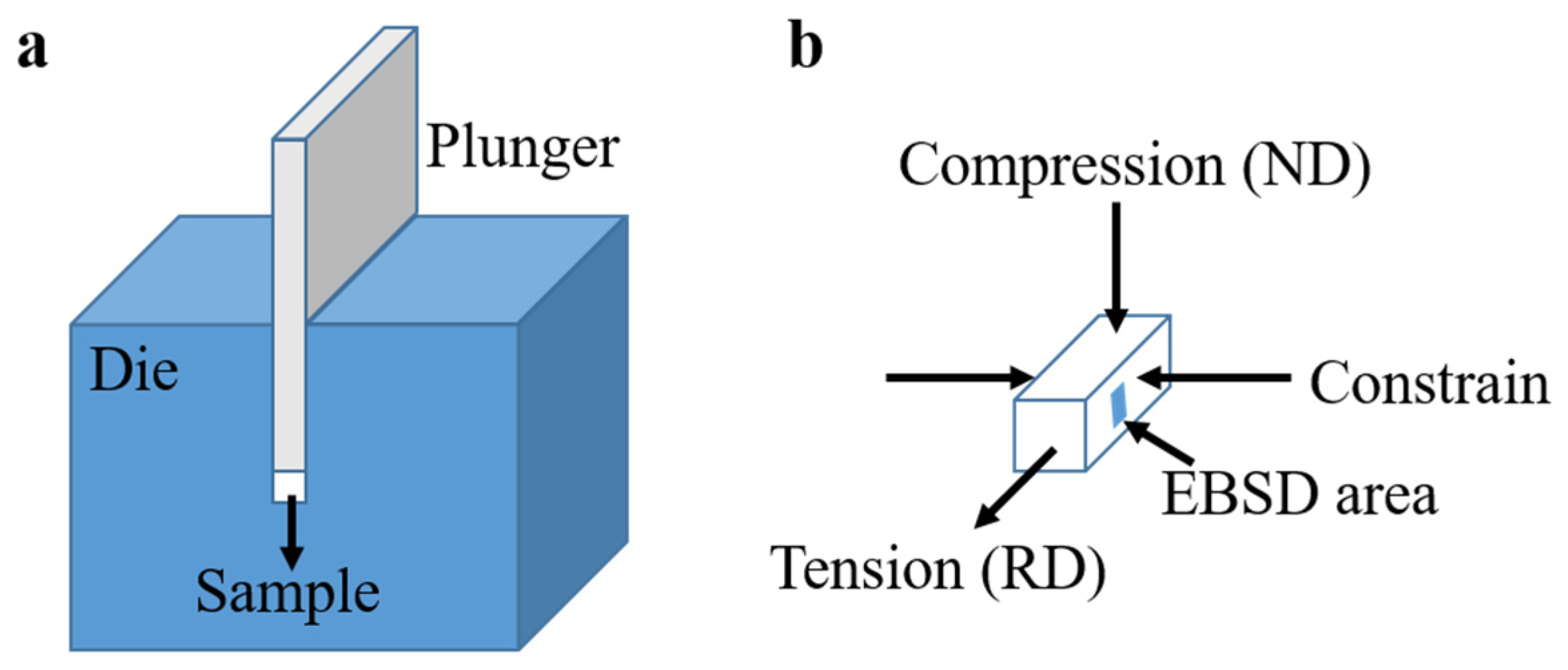
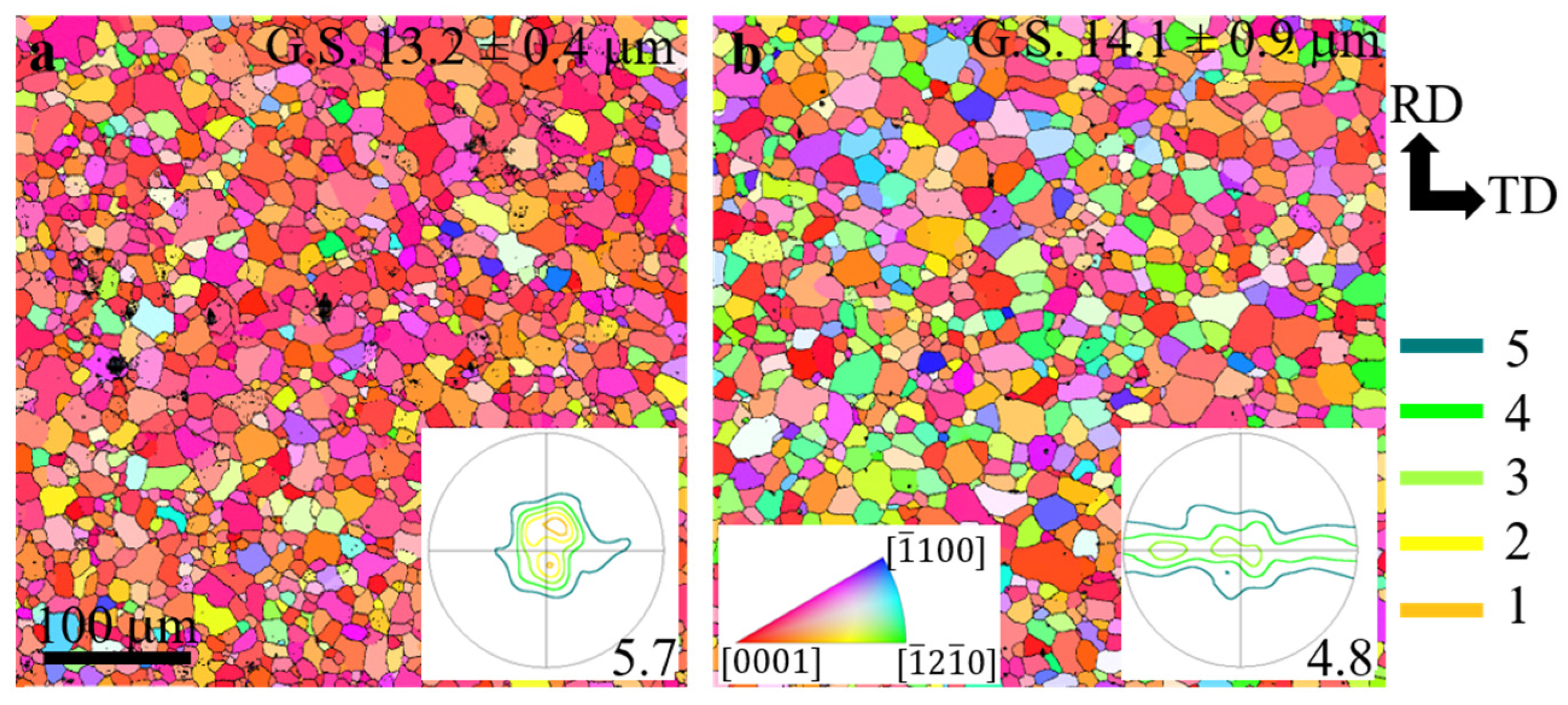
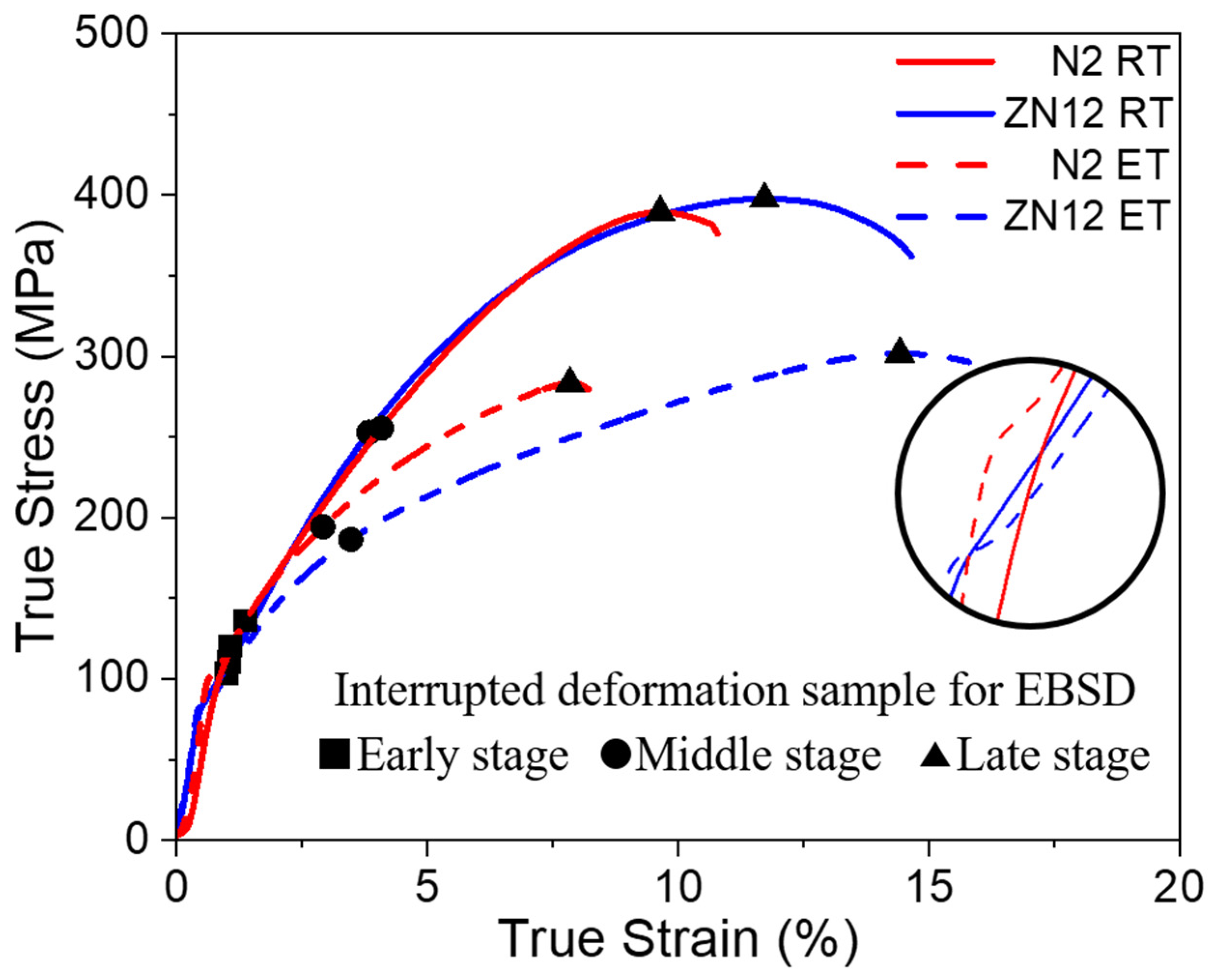

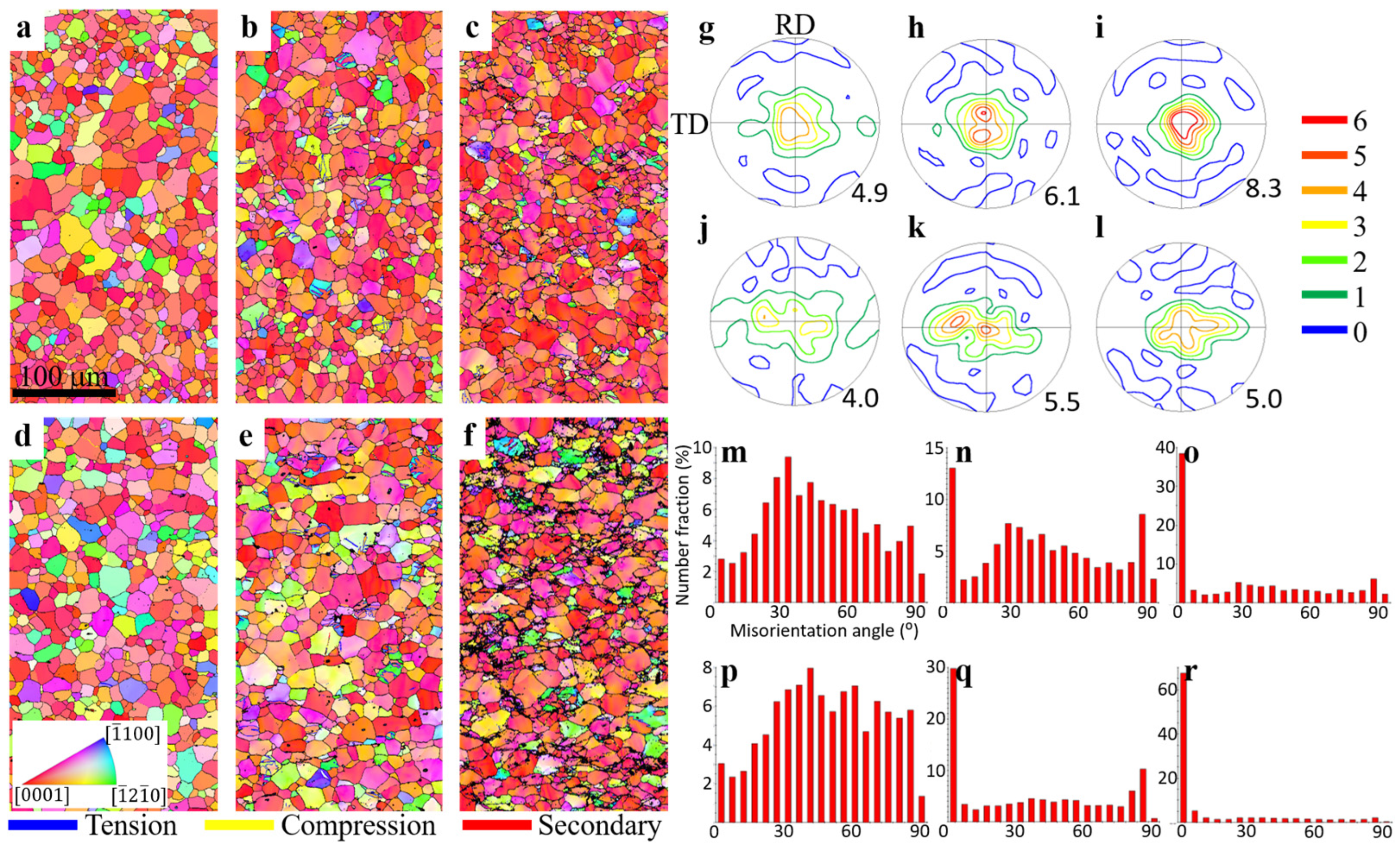
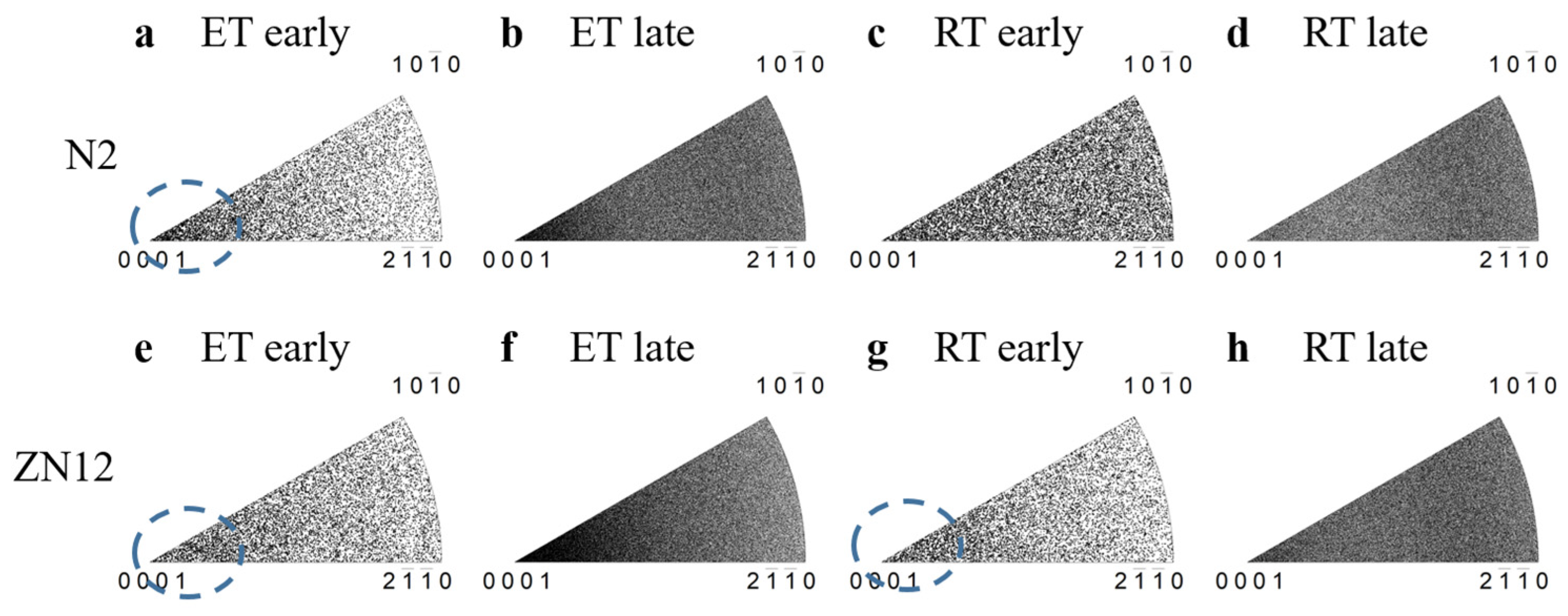
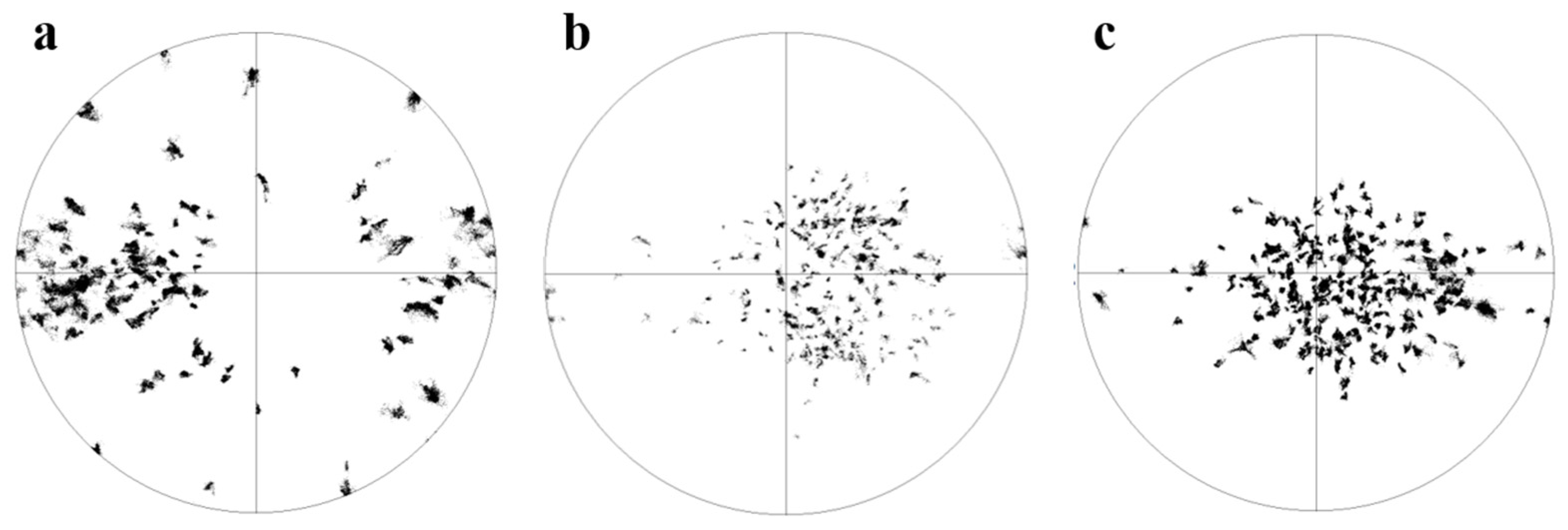
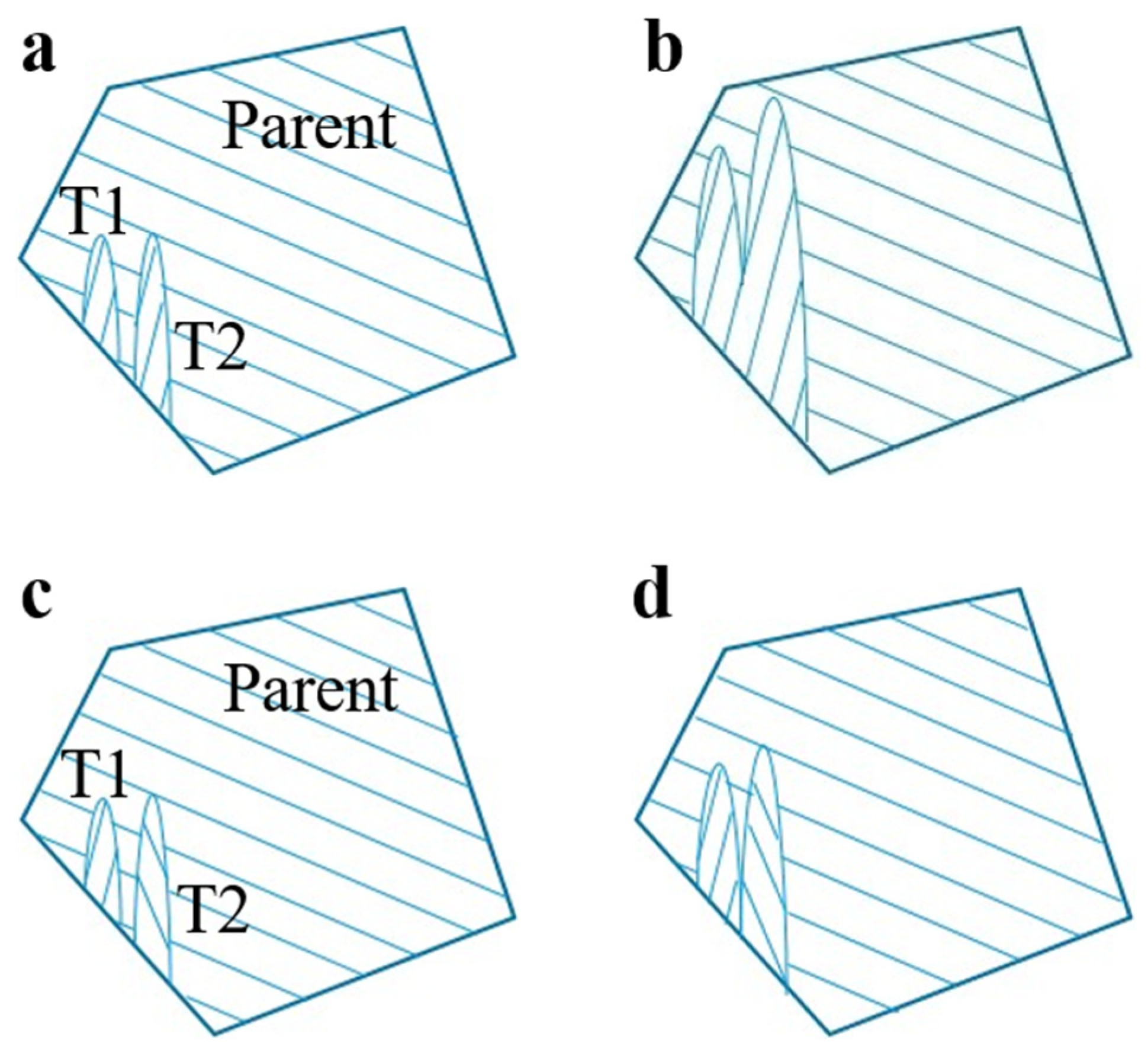
| Alloy | Nd | Zn | Mg |
| Mg-Nd (N2) | 1.75 | - | Balanced |
| Mg-Zn-Nd (ZN12) | 1.71 | 1.07 | Balanced |
| Yield Strength (MPa) | Ultimate Strength (MPa) | Fracture Strain (%) | |
|---|---|---|---|
| N2 RT | 120 ± 3.1 | 390 ± 6.8 | 11.1 ± 0.3 |
| N2 ET | 104 ± 2.2 | 283 ± 4.0 | 8.3 ± 0.4 |
| ZN12 RT | 95 ± 3.2 | 398 ± 7.3 | 14.9 ± 0.4 |
| ZN12 ET | 87 ± 1.8 | 302 ± 6.6 | 17.7 ± 0.2 |
| Early Stage | Middle Stage | Late Stage | |
|---|---|---|---|
| N2 RT | 4.2 | 10.5 | 13.0 |
| N2 ET | 0 | 6.1 | 5.3 |
| ZN12 RT | 6.9 | 20.6 | 18.8 |
| ZN12 ET | 0.2 | 13.3 | 8.7 |
Disclaimer/Publisher’s Note: The statements, opinions and data contained in all publications are solely those of the individual author(s) and contributor(s) and not of MDPI and/or the editor(s). MDPI and/or the editor(s) disclaim responsibility for any injury to people or property resulting from any ideas, methods, instructions or products referred to in the content. |
© 2023 by the authors. Licensee MDPI, Basel, Switzerland. This article is an open access article distributed under the terms and conditions of the Creative Commons Attribution (CC BY) license (https://creativecommons.org/licenses/by/4.0/).
Share and Cite
Zeng, X.; Yi, S. Deformation Mechanisms of Magnesium Alloys with Rare-Earth and Zinc Additions under Plane Strain Compression. Materials 2024, 17, 33. https://doi.org/10.3390/ma17010033
Zeng X, Yi S. Deformation Mechanisms of Magnesium Alloys with Rare-Earth and Zinc Additions under Plane Strain Compression. Materials. 2024; 17(1):33. https://doi.org/10.3390/ma17010033
Chicago/Turabian StyleZeng, Xun, and Sangbong Yi. 2024. "Deformation Mechanisms of Magnesium Alloys with Rare-Earth and Zinc Additions under Plane Strain Compression" Materials 17, no. 1: 33. https://doi.org/10.3390/ma17010033




